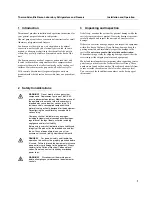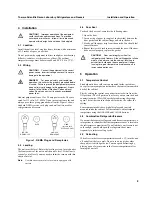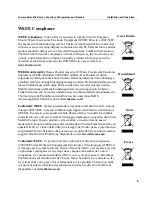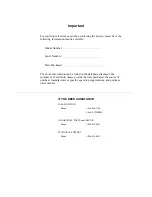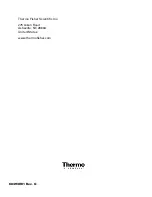
1
Thermo Scientific Revco Laboratory Refrigerators and Freezers
Installation and Operation
1
Introduction
This manual provides installation and operation instructions for
your general purpose laboratory refrigerator.
General purpose units have conventional construction for small
laboratory refrigerators and freezers.
Condensers are the static type: air circulation is by natural
convection, not forced by an electrically driven fan. In some
models, condensers are built into the sidewalls of the unit; in
others, they are fully visible coils mounted on the back of the
unit.
Condensate pans are made of copper or galvanized steel and
located in the machine compartment, where compressor heat
evaporates the water that collects naturally on the cooling coil
surfaces. Water drains to the pan on the off or defrost cycle.
Cold controls (thermostats) for general purpose units are
mounted inside the cabinet and accessible from an open cabinet
door.
2
Safety Considerations
WARNING!
Do not modify or change system
components. Replacement parts must be O.E.M.
exact replacement equipment. Modification or use of
the equipment in a manner other than expressly
intended may cause death or serious injury. This
includes use of user-supplied components and
materials not specifically designed for the equipment.
Reconfiguring the controller may cause death or
serious injury.
Company shall not be liable for any damages,
including incidental and/or consequential damages,
regardless of the legal theory asserted, including
negligence and/or strict liability.
Before using, user shall determine the suitability and
integrity of the product for the intended use and that
the unit has not been altered in any way. User
assumes all risk and liability whatsoever therewith.
DANGER!
For personal safety and trouble-free
operation, this unit must be properly grounded before
it is used. Failure to ground the equipment may cause
personal injury or damage to the equipment. Always
conform to the National Electrical Code and local
codes. Do not connect unit to already overloaded
power lines.
WARNING!
Disconnect unit from main power
before attempting any maintenance to equipment or
controls.
3
Unpacking and Inspection
At delivery, examine the exterior for physical damage while the
carrier’s representative is present. If exterior damage is present,
carefully unpack and inspect the unit and all accessories for
damage.
If there is no exterior damage, unpack and inspect the equipment
within five days of delivery. If you find any damage, keep the
packing materials and immediately report the damage to the
carrier.
Do not return goods without written authorization.
When submitting a claim for shipping damage, request that the
carrier inspect the shipping container and equipment.
Model and serial numbers are important when requesting service
parts from your dealer or the Technical Services Group. These
numbers are found on the outside of the cabinet, bottom left front
corner or inside the cabinet on the left wall at about eye level.
You can record the identification numbers on the back page of
this manual.




